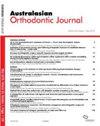Changes in pharyngeal airway space and hyoid bone position after Bionator treatment of skeletal Class II malocclusions
IF 0.9
4区 医学
Q4 DENTISTRY, ORAL SURGERY & MEDICINE
引用次数: 0
Abstract
Abstract Objectives The objective of this study was to investigate the treatment effectiveness of long-term Bionator use on the craniofacial pattern, nasopharynx, oropharynx, hypopharynx, hyoid bone, and cervical vertebrae in patients presenting with a skeletal Class II malocclusion involving mandibular retrognathia. Methods A treatment group of 27 patients with a skeletal Class II malocclusion treated using a Bionator was compared with a control group of 27 patients presenting with a skeletal Class I malocclusion managed without Bionator treatment. The Bionator was worn in the subject group until the complete eruption of the second molars. Lateral cephalograms of the group before (T0) and after Bionator treatment (T1) were compared. A two-way analysis of variance and a paired t-test were applied for statistical analyses. Results A significant increase in the SNB angle and a decrease in the ANB angle were apparent in the Bionator treatment group. The dimensions of the oropharyngeal and hypopharyngeal airways and the hypopharyngeal area increased significantly. Conclusion Long-term treatment using a Bionator resulted in the advancement of a retrognathic mandible. In addition, the dimensions of the oropharyngeal and hypopharyngeal airways and the hypopharyngeal area increased significantly, reaching the same level as that of skeletal Class I subjects.Bionator治疗骨ⅱ类错颌后咽气道间隙和舌骨位置的变化
摘要目的本研究的目的是研究长期使用Bionator对伴有下颌后颌畸形的骨骼II类错牙合患者的颅面模式、鼻咽、口咽、下咽、舌骨和颈椎的治疗效果。方法对27例使用Bionator治疗的骨骼II类错牙合畸形患者的治疗组与27例未使用Bionater治疗的骨骼I类错牙合畸形患者的对照组进行比较。受试者组佩戴Bionator,直到第二磨牙完全萌出。比较两组在Bionator治疗前(T0)和治疗后(T1)的侧位头影。采用双向方差分析和配对t检验进行统计分析。结果Bionator治疗组的SNB角明显增加,ANB角明显降低。口咽和下咽气道的尺寸以及下咽面积显著增加。结论使用Bionator进行长期治疗可使下颌后颌骨前移。此外,口咽和下咽气道的尺寸以及下咽面积显著增加,达到与骨骼I类受试者相同的水平。
本文章由计算机程序翻译,如有差异,请以英文原文为准。
求助全文
约1分钟内获得全文
求助全文
来源期刊

Australasian Orthodontic Journal
Dentistry-Orthodontics
CiteScore
0.80
自引率
25.00%
发文量
24
期刊介绍:
The Australasian Orthodontic Journal (AOJ) is the official scientific publication of the Australian Society of Orthodontists.
Previously titled the Australian Orthodontic Journal, the name of the publication was changed in 2017 to provide the region with additional representation because of a substantial increase in the number of submitted overseas'' manuscripts. The volume and issue numbers continue in sequence and only the ISSN numbers have been updated.
The AOJ publishes original research papers, clinical reports, book reviews, abstracts from other journals, and other material which is of interest to orthodontists and is in the interest of their continuing education. It is published twice a year in November and May.
The AOJ is indexed and abstracted by Science Citation Index Expanded (SciSearch) and Journal Citation Reports/Science Edition.
 求助内容:
求助内容: 应助结果提醒方式:
应助结果提醒方式:


